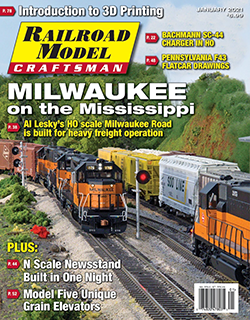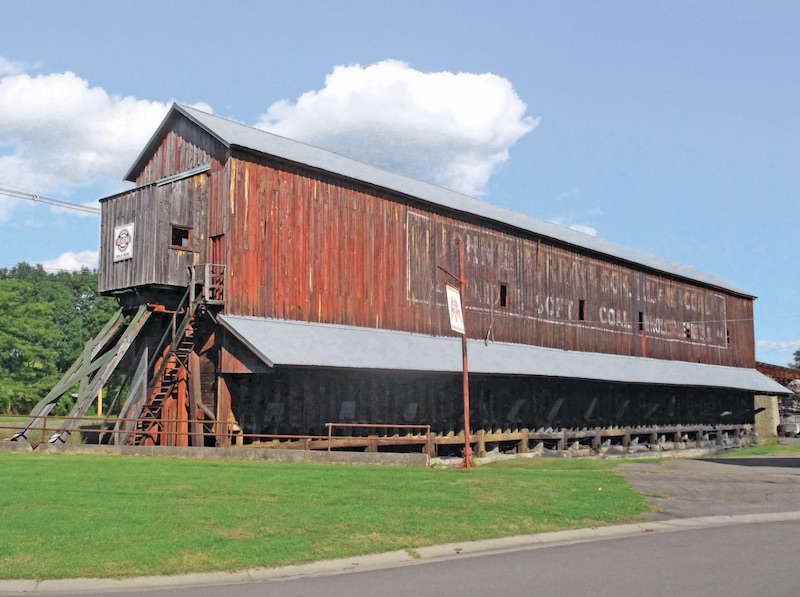 Years ago, it seemed many people modeled what they consider to be the “golden age” of railroading from the 1930s to the 1950s. Steam reigned supreme back in those days and so it’s easy to see why it’s an appealing setting for a model railroad. As time goes on, it seems to me people’s modeling interests are creeping forward in time. That makes sense, of course, since we all tend to model subjects and eras that are familiar to us, especially things we saw as a kid. But even as more people model the modern diesel era, there is still room for something from classic steam days on our layouts.
Years ago, it seemed many people modeled what they consider to be the “golden age” of railroading from the 1930s to the 1950s. Steam reigned supreme back in those days and so it’s easy to see why it’s an appealing setting for a model railroad. As time goes on, it seems to me people’s modeling interests are creeping forward in time. That makes sense, of course, since we all tend to model subjects and eras that are familiar to us, especially things we saw as a kid. But even as more people model the modern diesel era, there is still room for something from classic steam days on our layouts.
Up through the 1960s, coal was everywhere. Railroads used coal to fuel locomotives, many homes were still heated with it, and many power plants and heavy industries depended on it. There was of course a need to store it, specifically in towers and silos that were scattered around the country. Every town had a coal dealer (or two), and every engine facility had a coal tower. Of course, as coal use declined, so was our awareness of it as coal delivery trucks and storage facilities seemed to vanish — although not all of them disappeared.
I got to thinking about these old coal facilities recently when I was looking through some old photos of Rochester, N.Y., that I had taken in the 1980s. I had been looking for photos of some scenes that are depicted on the Rochester Institute of Technology’s club layout when I stumbled upon images of old coal silos, one concrete and the other wooden. Both were weather-beaten, but even in the 1980s they both looked as if they could still be used. The only sign that they might not have been in use was the lack of a siding.
Located downtown until 2015 was the ruins of the Yates Coal Co., with an elevated coal trestle (the shed burned in the 1970s), concrete silos, and a small office. The only thing remaining on site today is the one stone abutment for the trestle leading to the dock.
Not far from Rochester is the Coal Tower Restaurant in Pittsford, built around — you guessed it — an old coal tower used by a local fuel dealer until 1967. The steel silo is a prominent landmark, and the concrete supports and coal chutes are part of the restaurant’s interior. Certainly an interesting idea for adaptive reuse on your modern layout!
Rare among these specimens is the John H. Murray & Son coal dock in Sayre, Pa., a relic right out of the Depression era, with its large wooden shed and trestle still in use today.
Port Jervis, N.Y., was once an important division point on the Erie Railroad, home to a large roundhouse and service facility. The roundhouse burned in the 1970s, but the coaling towers over the fuel tracks remained. The haunting reminder of the steam era was a backdrop for modern commuter trains until 2001.
These memories sent me down the rabbit hole looking for other similar structures in my files. I discovered another coal tower in 1993 along the Boston & Maine in Westminster, Mass. Even at that late date, there was still a siding leading to it, although it had been decades since a coal car was spotted there. Unless you are a railroad enthusiast, most people — like the ones passing on commuter trains every day — probably never even notice it. It was still standing in 2008.
Another coal pocket I remember was also along the Boston & Maine’s old Worcester, Nashua & Rochester near East Pepperell, Mass. When I first saw it in the mid-1960s, the wood portion was mostly gone, but the concrete structure that remained was still visible. The tracks were abandoned and later removed in the 1980s. In 1985, a bike path was built on the right-of-way. When I finally stopped to take a few photos in 2001, it was still there, as it was when I stopped again in 2020. It’s not going anywhere, apparently.
Concrete lasts a long time, and if they don’t have to, most communities or companies are not going to spend the money to remove these structures. That’s an important fact for modelers like us. If you model “modern” times (basically anytime in the last 50 years), out-of-service coal structures don’t necessarily look out of place. Many of our layout structures such as houses, hotels, and restaurants are included to achieve a look and feel for an area and era. Coal facilities are just another example of this, but more rail-related. It shows what used to take place in a certain scene. If done well this can also be something that attracts attention to a part of the scene if desired. Better yet, it gives us a reason to use these “out of date” but still interesting structures, be they from a kit or scratchbuilt. —Bruce White



